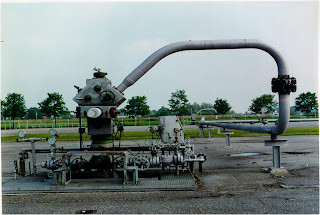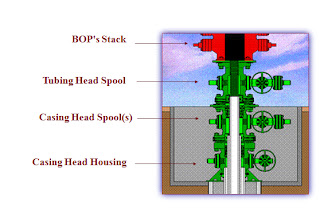Once a natural gas or oil well is drilled, and it has been verified that commercially viable quantities of natural gas are present for extraction, the well must be 'completed' to allow for the flow of petroleum or natural gas out of the formation and up to the surface. This process includes strengthening the well hole with casing, evaluating the pressure and temperature of the formation, and then installing the proper equipment to ensure an efficient flow of natural gas out of the well
Completing a well consists of a number of steps: installing the well casing, completing the well, installing the wellhead, and installing lifting equipment or treating the formation should that be required. Click on the links below to learn about these aspects of the well completion process:
1- Well Casing
2- Completion
3- The Wellhead
4- Lifting and Well Treatment
1-Well Casing
Installing well casing is an important part of the drilling and completion process. Well casing consists of a series of metal tubes installed in the freshly drilled hole. Casing strengthens the sides of the well hole, ensures that no oil or natural gas seeps out of the well hole as it is brought to the surface, and keeps other fluids or gases from seeping into the formation through the well. A good deal of planning is necessary to ensure that the proper casing for each well is installed. The type of casing used depends on the subsurface characteristics of the well, including the diameter of the well and the pressures and temperatures experienced throughout the well. The diameter of the well hole depends on the size of the drill bit used. In most wells, the diameter of the well hole decreases the deeper it is drilled, leading to a type of conical shape that must be taken into account when installing casing.
There are five different types of well casing. They include:
Conductor Casing
Surface Casing
Intermediate Casing
Liner String
Production Casing
2-Completion
Well completion commonly refers to the process of finishing a well so that it is ready to produce oil or natural gas. In essence, completion consists of deciding on the characteristics of the intake portion of the well in the targeted hydrocarbon formation. There are a number of types of completions, including:
Open Hole Completion
Conventional Perforated Completion
Sand Exclusion Completion
Permanent Completion
Multiple Zone Completion
Drainhole Completion
The use of any type of completion depends on the characteristics and location of the hydrocarbon formation to be mined.
Open Hole Completion
Open hole completions are the most basic type and are used in formations that are unlikely to cave in. An open hole completion consists of simply running the casing directly down into the formation, leaving the end of the piping open without any other protective filter. Very often, this type of completion is used on formations that have been ‘acidized’ or ‘fractured.’
Conventional Perforated Completion
Conventional perforated completions consist of production casing being run through the formation. The sides of this casing are perforated, with tiny holes along the sides facing the formation, which allows for the flow of hydrocarbons into the well hole, but still provides a suitable amount of support and protection for the well hole. The process of perforating the casing involves the use of specialized equipment designed to make tiny holes through the casing, cementing, and any other barrier between the formation and the open well. In the past, 'bullet perforators' were used, which were essentially small guns lowered into the well. The guns, when fired from the surface, sent off small bullets that penetrated the casing and cement. Today, 'jet perforating' is preferred. This consists of small, electrically-ignited charges, lowered into the well. When ignited, these charges poke tiny holes through to the formation, in the same manner as bullet perforating.
Sand Exclusion Completion
Sand exclusion completions are designed for production in an area that contains a large amount of loose sand. These completions are designed to allow for the flow of natural gas and oil into the well, but at the same time prevent sand from entering the well. Sand inside the well hole can cause many complications, including erosion of casing and other equipment. The most common methods of keeping sand out of the well hole are screening or filtering systems. These include analyzing the sand experienced in the formation and installing a screen or filter to keep sand particles out. The filter may be either a type of screen hung inside the casing, or a layer of specially-sized gravel outside the casing to filter out the sand. Both types of sand barriers can be used in open holes and perforated completions.
Permanent Completion
Permanent completions are those in which the components are assembled and installed only once. Installing the casing, cementing, perforating, and other completion work is done with small diameter tools to ensure the permanent nature of the completion. Completing a well in this manner can lead to significant cost savings compared to other types.
Multiple Zone Completion
Multiple zone completion is the practice of completing a well so that hydrocarbons from two or more formations may be produced simultaneously, yet separately. For example, a well may be drilled that passes through a number of formations as it descends; alternately, it may be more effective in a horizontal well to add multiple completions to drain the formation efficiently. Although it is common to separate multiple completions so that the fluids from the different formations do not intermingle, the complexity of achieving complete separation can present a barrier. In some instances, the different formations being drilled are close enough to allow fluids to intermingle in the well hole. When it is necessary to prevent this intermingling, hard rubber 'packing' instruments are used to maintain separation among different completions.
Drainhole Completion
Drainhole completions are a form of horizontal or slant drilling. This type of completion consists of drilling out horizontally into the formation from a vertical well, providing a 'drain' for the hydrocarbons to empty into the well. In certain formations, drilling a drainhole completion may allow for more efficient and balanced extraction of the targeted hydrocarbons. Drainhole completions are more commonly associated with oil wells than with natural gas wells.
3-The Wellhead
A Wellhead
Source: NETL - DOE
The wellhead consists of the pieces of equipment mounted at the opening of the well to manage the extraction of hydrocarbons from the underground formation. It prevents leaking of oil or natural gas out of the well, and also prevents blowouts caused by high pressure. Formations that are under high pressure typically require wellheads that can withstand a great deal of upward pressure from the escaping gases and liquids. These wellheads must be able to withstand pressures of up to 20,000 pounds per square inch (psi)
Lifting and Well Treatment
Once the well is completed, it may begin to produce natural gas. In some instances, the hydrocarbons that exist in pressurized formations will naturally rise up through the well to the surface. This is most commonly the case with natural gas. Since natural gas is lighter than air, once a path to the surface is opened, the pressurized gas will rise to the surface with little or no interference. This is most common for formations containing natural gas alone, or with only a light condensate. In these scenarios, once the christmas tree is installed, the natural gas will flow to the surface without assistance.
In order to more fully understand the nature of the well, a potential test is typically run in the early days of production. This test allows well engineers to determine the maximum amount of natural gas that the well can produce in a 24-hour period. From this and other knowledge of the formation, the engineer may make an estimation on what the 'most efficient recovery rate', or MER will be. The MER is the rate at which the greatest amount of natural gas may be extracted without harming the formation itself.
Another important aspect of producing wells is the 'decline rate'. When a well is first drilled, the formation is under pressure and produces natural gas at a very high rate. However, as more and more natural gas is extracted from the formation, the production rate of the well decreases. This is known as the decline rate. Certain techniques, including lifting and well stimulation, can increase the production rate of a well.
A Horse Head Pump
Source: ChevronTexaco Corporation
In some natural gas wells, and oil wells that have associated natural gas, it is more difficult to ensure an efficient flow of hydrocarbons up the well. The underground formation may be very 'tight', making the movement of petroleum through the formation and up the well a very slow and inefficient process. In these cases, lifting equipment or well treatment is required.
Lifting equipment consists of a variety of specialized equipment used to help 'lift' petroleum out of a formation. This is most commonly used to extract oil from a formation. Because oil is found as a viscous liquid, it takes some coaxing to extract it from underground. Various types of lifting equipment are available, but the most common lifting method is known as 'rod pumping'. Rod pumping is powered by a surface pump that moves a cable and rod up and down in the well, providing the lifting pressure required to bring the oil to the surface. The most common type of cable rod lifting equipment is the 'horse head' or conventional beam pump. These pumps are recognizable by the distinctive shape of the cable feeding fixture, which resembles a horse's head.
4-Well Treatment
Well treatment is another method of ensuring the efficient flow of hydrocarbons out of a formation. Essentially, this type of well stimulation consists of injecting acid, water, or gases into the well to open up the formation and allow the petroleum to flow through the formation more easily. Acidizing a well consists of injecting acid (usually hydrochloric acid) into the well. In limestone or carbonate formations, the acid dissolves portions of the rock in the formation, opening up existing spaces to allow for the flow of petroleum. Fracturing consists of injecting a fluid into the well, the pressure of which 'cracks' or opens up fractures already present in the formation. In addition to the fluid being injected, 'propping agents' are also used. These propping agents can consist of sand, glass beads, epoxy, or silica sand, and serve to prop open the newly widened fissures in the formation. Hydraulic fracturing involves the injection of water into the formation, while CO2 fracturing uses gaseous carbon dioxide. Fracturing, acidizing, and lifting equipment may all be used on the same well to increase permeability, widening the pores of the formation.

















